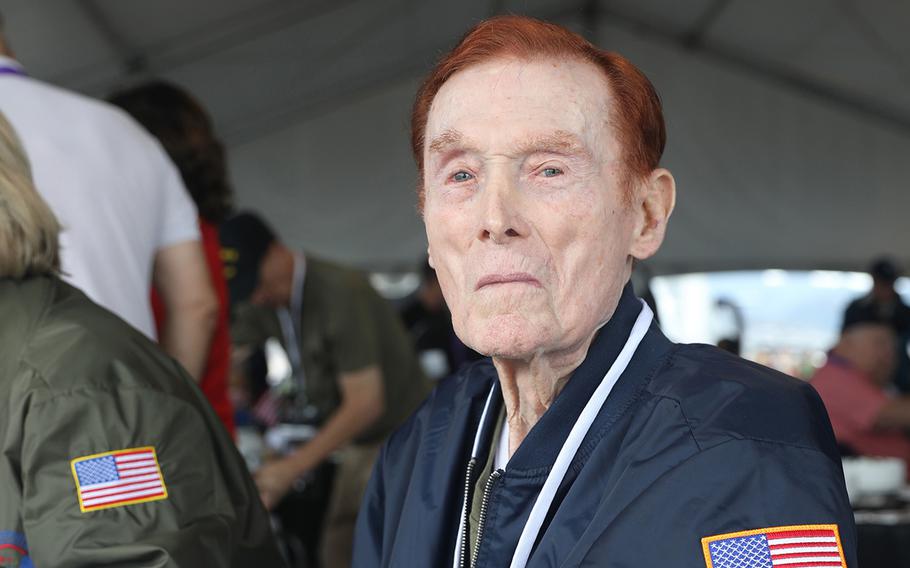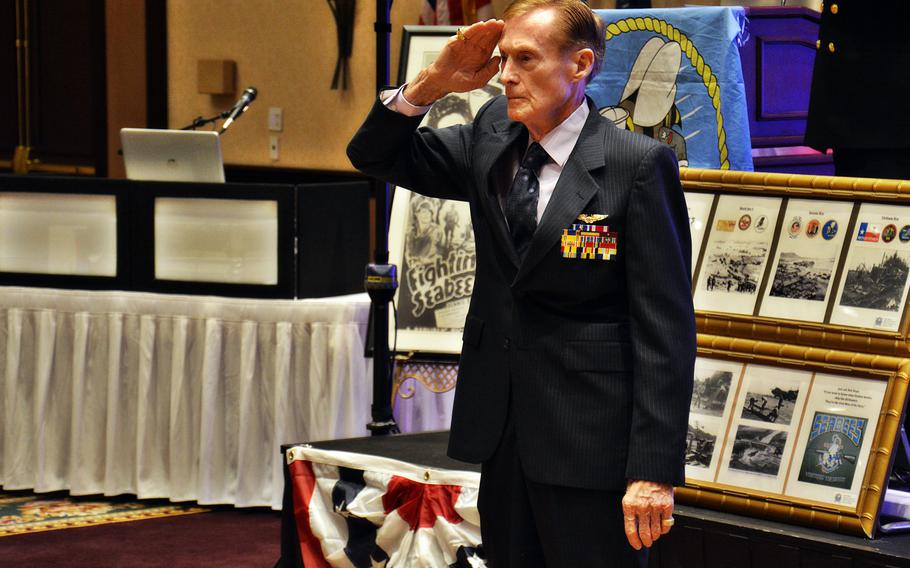
Jack Holder attends a luncheon aboard the Battleship Missouri Memorial in Hawaii, Dec. 7, 2021. (Ernesto Bonilla/U.S. Navy)
Jack Holder, a sailor whose service during World War II included the surprise attack on Pearl Harbor, the Battle of Midway and flying dozens of B-24 bomber missions over the English Channel, died Friday. He was 101.
His death was announced Sunday in a Facebook post by Darlene Tryon, a retired Air Force master sergeant who is the executor of Holder’s estate.
Tryon wrote that she was at Holder’s side when he died at Chandler Regional Medical Center in Chandler, Ariz.
For more than four decades after the war’s end, Holder rarely spoke of his Forrest Gump-like presence at key events of the conflict, Tryon wrote.
That changed in the late 1980s, however, when he was invited to join a veterans’ honor flight and visited war memorials in Washington, D.C., she wrote.
The trip inspired him to become a regular at Pearl Harbor commemorations and to speak at museums and schools of his experiences, she wrote.

Jack Holder, a Navy veteran who saw action during the 1941 attack on Pearl Harbor, Battles of Midway and Guadalcanal and in Europe is honored during a celebration of the Navy’s 239th birthday at the Scottsdale Plaza Resort, Scottsdale, Ariz., Oct. 11, 2014. (Drew Verbis/U.S. Navy)
Holder, an only child, was raised on a farm in Gunter, Texas, and joined the Navy in 1940 immediately after graduating from high school, he said in a videotaped interview published online in 2020 by The Log Book Project.
He was stationed at Ford Island on Pearl Harbor late that year, where he was a crew member aboard an amphibious patrol bomber, or PBY, as part of PBY Squadron VP-23.
During the months before the war began, Holder rose to the position of flight engineer.
On the morning of Dec. 7, 1941, he had just lined up for muster inside the squadron hangar, with the section leader commencing roll call, he said in the interview.
“We heard the screaming aircraft and moments later a terrible explosion,” he said. They ran outside and found the hangar next to theirs engulfed in flames and smoke.
Most of the PBY aircraft standing between the hangars were damaged during that bombing, he said.
The sailors raced for a nearby ditch being dug for a new sewer line. One Japanese plane strafed them as they crouched there, missing them by only a few feet.
“I’ve been asked so many times: ‘What were your thoughts at that time?’ ” he said in the interview. “But you have so many it’s hard to describe — fear, anger, surprise, whatever, you know?”
“My most vivid memory was, ‘God, please don’t let me die in this ditch.’ ”
Sleeping on the wing
Six months later, on June 4, 1942, Holder was aboard his PBY, which was armed with four 500-pound bombs and on the hunt for submarines as the Japanese commenced with their plan to take the island of Midway.
Unbeknownst to Japan, the U.S. had broken its secret code and anticipated what came to be known as the Battle of Midway, regarded by many historians as the turning point in the war in the Pacific.
The Japanese fleet was caught by surprise by the U.S. Navy and lost almost 300 planes, a cruiser, four aircraft carriers and about 2,500 men.
Holder’s plane dropped two bombs on a Japanese submarine, destroying it.
“Later in the afternoon, we lost all contact with Midway, and we didn’t know if we had it or the Japanese had it,” Holder recalled in the interview.
“We had a decision to make: We could return to Midway, or we could drop our remaining bombs and set down at sea,” he said. “We dropped our remaining bombs, landed and drifted all night. I took a sleeping bag, climbed on top of the wing, tied myself to an antenna and spent the evening.”
At sunup they learned from Midway that it was still in friendly hands.
Later that summer, Holder’s PBY squadron headed to the Solomon Islands, flying 48 missions over seven months during the Battle of Guadalcanal.
“We returned most days with bullet holes in the aircraft,” recalled Holder, who manned one of the two .50-caliber machine guns on the plane. Sometimes they made it back to base with only one engine still functioning.
From Pacific to Atlantic
Holder was then sent back to San Diego to train on the B-24 Liberator bomber for hunting German submarines off the European coast.
In the interview, he recalled contending with Messerschmitt fighters, during which his B-24 would head for cloud cover to escape attack. The Liberator would then barrel from the cloud at top speed in hopes of catching a Messerschmitt by surprise.
“You know, it’s either you or him,” he said.
Holder was awarded two Distinguished Flying Cross medals and one Presidential Citation, among other awards during the war.
He was honorably discharged from the Navy in 1948 and worked in the aviation industry for 25 years. He formed the Texco Oil Co., on which he served as board chair and president for four years.